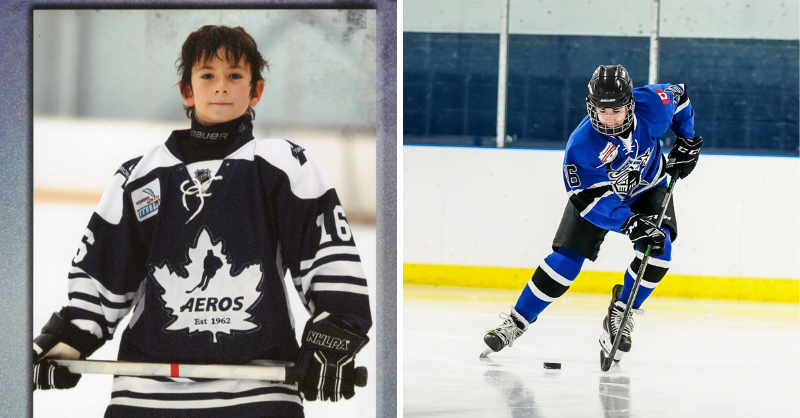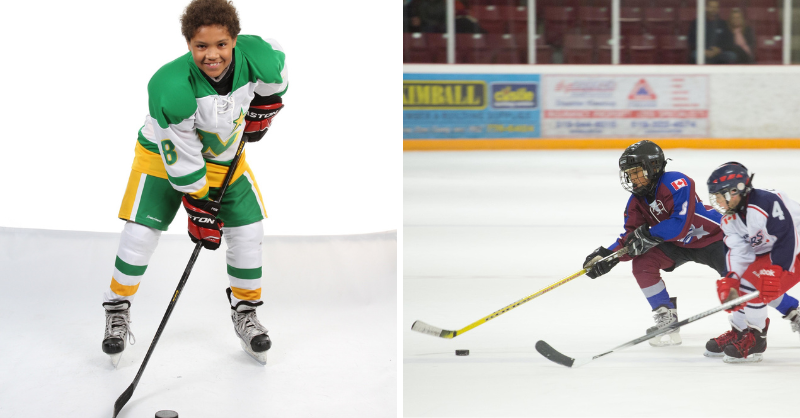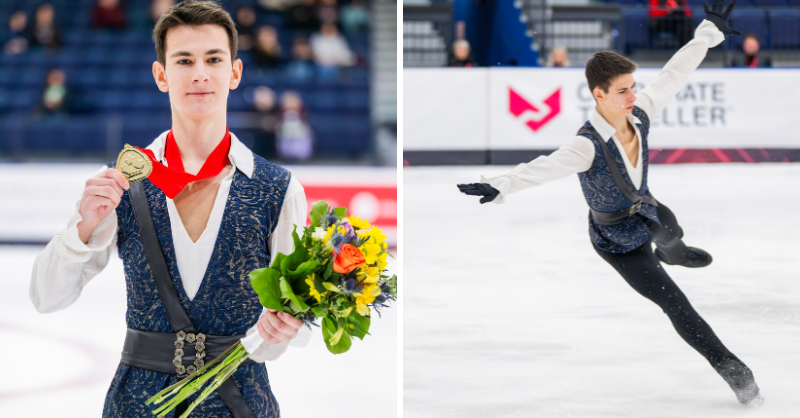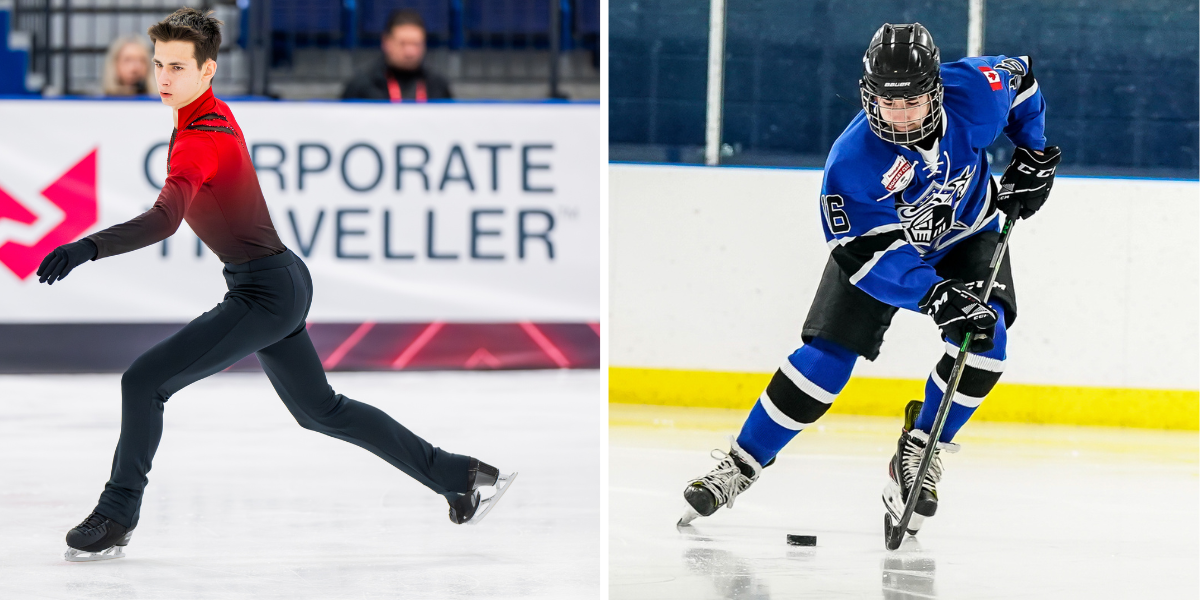Beyond the Boards: The Connection Between Figure Skating and Hockey
Figure skating and hockey may seem like opposite worlds on the ice, with one focused on artistry and precision, the other on speed and power. But the balance, edge control, and body alignment that define strong figure skating are the same skills that help make great hockey players.
From youth programs to professional hockey, players at every level benefit from figure skating techniques. Even NHL teams rely on skating consultants and retired figure skaters to improve players’ skating skills and overall performance.
Beyond using figure skating as a training tool, some athletes have embraced both sports fully. David Bondar, the 2025 Canadian National Junior Men’s Champion, and Kieran Thrasher, the two-time ISU Grand Prix Final bronze medalist in junior pairs, each grew up balancing hockey and figure skating — experiences that shaped their success on the ice. Their journeys reveal just how interconnected these ice sports are, and how figure skating builds a powerful foundation for all forms of skating.

David Bondar playing hockey.
Two Routes to the Rink
David Bondar first laced up his skates through the CanSkate program at just three years old where his love for the ice developed. As he continued progressing in figure skating, he dreamed of giving another ice sport a try: hockey.
By age seven, he had finally convinced his parents to let him join a team, and quickly realized his figure skating background gave him a clear advantage. His balance, control, and edge work helped him adapt quickly and outskate many of his peers.

Kieran Thrasher playing hockey.
Kieran Thrasher’s story started on the opposite path. He began with hockey and initially wanted nothing to do with figure skating. But after his mom encouraged him to join lessons with his sisters to improve his skating, his perspective shifted. The more time he spent taking lessons, the more he recognized how much it helped his hockey game, leading him to continue training in both sports, although hockey remained his focus.
On Ice Advantage
Both Bondar and Thrasher credit figure skating for improving their hockey performance.
Thrasher admitted that although he was hesitant to try figure skating, it made a significant difference in his game performance. “It made me more comfortable on the ice and improved my control while skating,” he stated.
Bondar had a similar experience, adding that cross-training gave him advantages in both sports. His endurance and stamina improved, which helped him figure skating, and he found himself often outskating his teammates thanks to his technical skating skills.
“I was out on the ice skating, running, hitting and I was usually tired at the end of every game so that meant I was working hard, building muscle and improving my stamina,” said Bondar.

Kieran Thrasher (left) at 2018 Skate Canada Challenge and David Bondar (right) at 2019 Skate Canada Challenge.
Balancing Both
Although there were major benefits, managing two high-intensity sports wasn’t always easy. For Bondar, it meant long days that started with figure skating training and ended with late night hockey games. This began to take a physical toll on his body, especially as hockey became more high-contact.
“I started waking up sore,” Bondar recalled. “It was starting to hurt my figure skating when I’d get injured from hockey.”
As his figure skating skills improved at a faster rate, the choice to focus became clear.
“When I was in novice I was improving and a lot of coaches told me that I can go really far in skating. So, I thought that it would be more beneficial to pursue figure skating at a high level.”

David Bondar at the 2025 Canadian National Skating Championships.
Meanwhile, for Thrasher, it wasn’t the physical demands of juggling both sports but the time commitments that became a challenge. Balancing both sports meant constant scheduling conflicts.
“Some days I’d have to miss hockey practice because I had a figure skating competition, or I’d miss skating because I had a hockey game” he shared.
After five years of juggling hockey and figure skating, Thrasher knew it wasn’t realistic to pursue both sports, so he decided to leave it up to the 2020 Ontario Hockey League draft. When he didn’t get drafted, he took it as a sign to fully dedicate himself to figure skating.
He moved to Oakville to train and later teamed up with Jazmine Desrochers with the pair later going on to win bronze at the ISU Grand Prix Final in junior pairs two years in a row.

Kieran Thrasher and partner Jazmine Desrochers at the 2025 Canadian National Skating Championships.
Advice to Young Skaters
For young athletes considering both hockey and figure skating, Bondar encourages giving it a try. “If you’re interested in both sports, go for it,” he says. “The benefits of doing both will show in your performance on the ice.”
Thrasher echoed a similar message: “Do it because you enjoy it, not because you feel pressured to.”
For hockey players who might be curious about figure skating, Thrasher understands the hesitation — recalling his own experience facing negative comments from others — but reminds them to stay focused on their goals.
“Even top hockey players learn from figure skaters,” he says. “If they are judging you for that, that’s their problem, not yours, because you are the one putting the work in.”
Bondar and Thrasher’s journeys prove there’s no single path to success on the ice. The balance, precision, and control gained through figure skating can give any hockey or ringette player a competitive edge. Through programs like Skate Canada’s PowerSkate, the next generation of athletes is discovering how figure skating techniques can build confidence and reach their full potential across ice sports.
